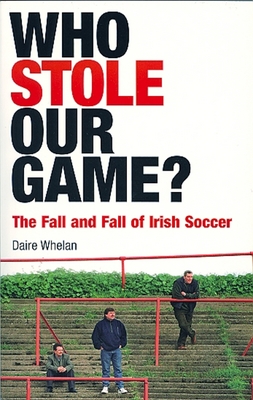Who Stole Our Game: the fall and fall of Irish soccer
Gerry Kelly reviews Who Stole Our Game: the fall and fall of Irish soccer by Daire Whelan published by Gill & Macmillan, ISBN 0-7171-4004-0, €14.99 pbk

FROM THE heyday of Irish soccer - not a term I like to use but one I use to differentiate between Gaelic and association football - in the 1950s until now, the author takes us on a seemingly endless downward journey.
Having finished reading this I felt dejected by the ineptitude of the individuals involved who have succeeded in taking the sport to the inglorious place it occupies in Irish society today.
The various associations and clubs all centre around strong egocentric personalities, thus widening the gap between local communities and the 'product', which they recognised soccer had become - while failing to embrace a systematic approach towards nurturing and developing the sport.
Whelan makes some interesting comparisons with the journey taken by Gaelic football, particularly from the mid-1970s.
For example, the links between the local community, the Catholic church and the local Gaelic football fan were crucial when it came to strategic local planning and organisation.
As a result, while new suburbs and communities sprang up during the 1970s, before the cement was dry on any new housing, a church and Gaelic football club sports fields, with facilities unsurpassed within local soccer circles, were securely in place.
Back in the 1970s, the Catholic church deemed it dangerous for these new communities to be without such facilities, especially a church. As a result soccer has had to exist on the margins of prevailing norms and authority, a condition from which it has never recovered.
For me, the author's recounting of the move by the former Milwall FC midfielder Eamon Dunphy to entice Wimbledon FC to move to Dublin in the late 90's demonstrates why it is so wrong for football to attempt to become a business or, in the case of teams like Manchester United and Liverpool, a 'global franchise'.
However, Dunphy's adventure with Johnny Giles, during the 70s in Europe with Shamrock Rovers, makes for great reading.
Even during Italia 90 when support for the national team was at an all time high the footballing authorities failed to capitalise on the abundant goodwill and interest in Ireland's participation.
What we are left with is a weakened league and a string of clubs including, for now, the national team, without a home, having to share facilities in area's far away from their historical fan base.
Ironically the national team will play at Croke Park the home of the ametuer Gaelic Football Association.
It is still the case that more people travel outside of Ireland to watch football matches in England and Scotland. which demonstrates an untapped market for a local soccer fanbase. There is a very strong youth setup in Ireland, but as this has links to professional teams in England and Scotland, thus ensures a continual flow of talent away from home.
Ireland's young talent has a professional league to aim for and they, understandably, are keen to play in it. I cannot knock any young person who when faced with the decision of choosing say, Sligo Rovers or Burnley , heads for the hills of Lancashire.
A senior Football Association of Ireland official was interviewed at the recent Carlsberg pre-season tournament and said he was glad his team was playing. The interviewer asked "is that Bohemians then", to which the reply came, "oh no, I support Liverpool."
This for me encapsulates what is wrong with the current strategy of those in charge of the game in Ireland. Daire Whelan raises the issues and asks the questions. However, it is clear that the answers are still out there waiting to be brought home.
Connolly Association, c/o RMT, Unity House, 39 Chalton Street, London, NW1 1JD
Copyright © 2007 Gerry Kelly

